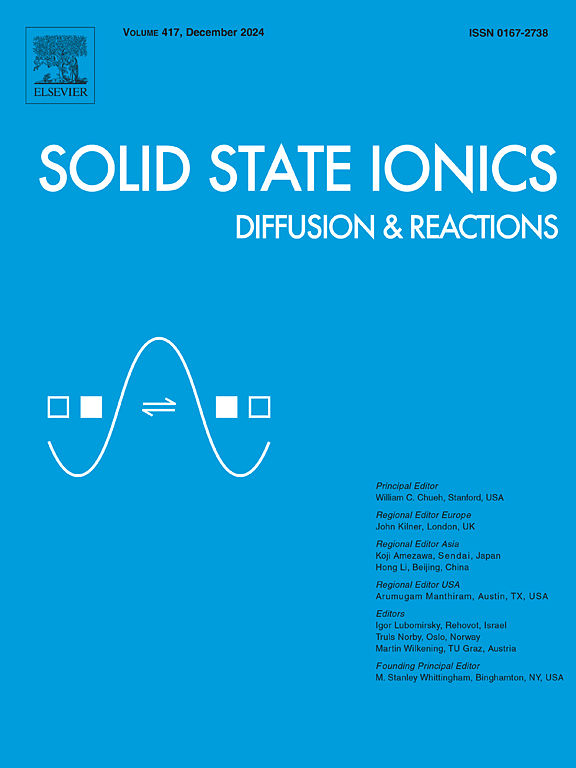Practical assessment of cobalt-free Li2MnO3-based layered materials for Li battery applications
IF 3
4区 材料科学
Q3 CHEMISTRY, PHYSICAL
引用次数: 0
Abstract
As cost-effective and Co-free positive electrode materials, a solid solution material between Li2MnO3 and LiNi0.5Mn0.5O2, Li1.2Ni0.2Mn0.6O2, delivers a large reversible capacity over 220 mA h g−1 through reversible anionic redox of oxide ions. However, a practical problem of this material is found in the insufficient reversibility as electrode materials associated with partial oxygen loss during charging process. In this study, Li1.2Al0.04Ni0.18Mn0.58O2, where Ni and Mn ions in Li1.2Ni0.2Mn0.6O2 are partially substituted with Al ions, is synthesized via a solid-state reaction. Li1.2Al0.04Ni0.18Mn0.58O2 samples with the optimized surface area are further synthesized at different calcination temperatures. Al3+-substituted sample with the optimized surface area partially suppresses the capacity fading and voltage decay on continuous electrochemical cycles, ∼ 500 cycles. Moreover, the use of highly concentrated electrolytes with high oxidative stability efficiently improves electrode reversibility of Li1.2Al0.04Ni0.18Mn0.58O2. Nevertheless, important practical problems are still found in inevitable voltage decay and inferior charge rate capability, both originating from the character of anionic redox reaction. Further research efforts are necessary to overcome these drawbacks and to adopt Mn-based electrode materials with anionic redox for practical battery applications, especially for electric vehicles.
锂电池应用中无钴li2mno3基层状材料的实际评估
Li1.2Ni0.2Mn0.6O2是一种介于Li2MnO3和LiNi0.5Mn0.5O2之间的固溶体材料,通过氧化离子的可逆阴离子氧化还原,提供了超过220 mA h g - 1的大可逆容量,是一种低成本、无co的正极材料。然而,这种材料的一个实际问题是作为电极材料的可逆性不足,在充电过程中会造成部分氧损失。本研究通过固相反应合成Li1.2Al0.04Ni0.18Mn0.58O2,将Li1.2Ni0.2Mn0.6O2中的Ni和Mn离子部分取代为Al离子。在不同的煅烧温度下,进一步合成了具有优化表面积的Li1.2Al0.04Ni0.18Mn0.58O2样品。优化表面积的Al3+取代样品在连续电化学循环(~ 500次)中部分抑制了容量衰减和电压衰减。此外,使用具有高氧化稳定性的高浓度电解质有效地提高了Li1.2Al0.04Ni0.18Mn0.58O2的电极可逆性。然而,由于阴离子氧化还原反应的特性,其电压衰减不可避免,充电速率能力较差,仍然存在重要的实际问题。需要进一步的研究来克服这些缺点,并采用具有阴离子氧化还原的锰基电极材料用于实际的电池应用,特别是用于电动汽车。
本文章由计算机程序翻译,如有差异,请以英文原文为准。
求助全文
约1分钟内获得全文
求助全文
来源期刊

Solid State Ionics
物理-物理:凝聚态物理
CiteScore
6.10
自引率
3.10%
发文量
152
审稿时长
58 days
期刊介绍:
This interdisciplinary journal is devoted to the physics, chemistry and materials science of diffusion, mass transport, and reactivity of solids. The major part of each issue is devoted to articles on:
(i) physics and chemistry of defects in solids;
(ii) reactions in and on solids, e.g. intercalation, corrosion, oxidation, sintering;
(iii) ion transport measurements, mechanisms and theory;
(iv) solid state electrochemistry;
(v) ionically-electronically mixed conducting solids.
Related technological applications are also included, provided their characteristics are interpreted in terms of the basic solid state properties.
Review papers and relevant symposium proceedings are welcome.
 求助内容:
求助内容: 应助结果提醒方式:
应助结果提醒方式:


